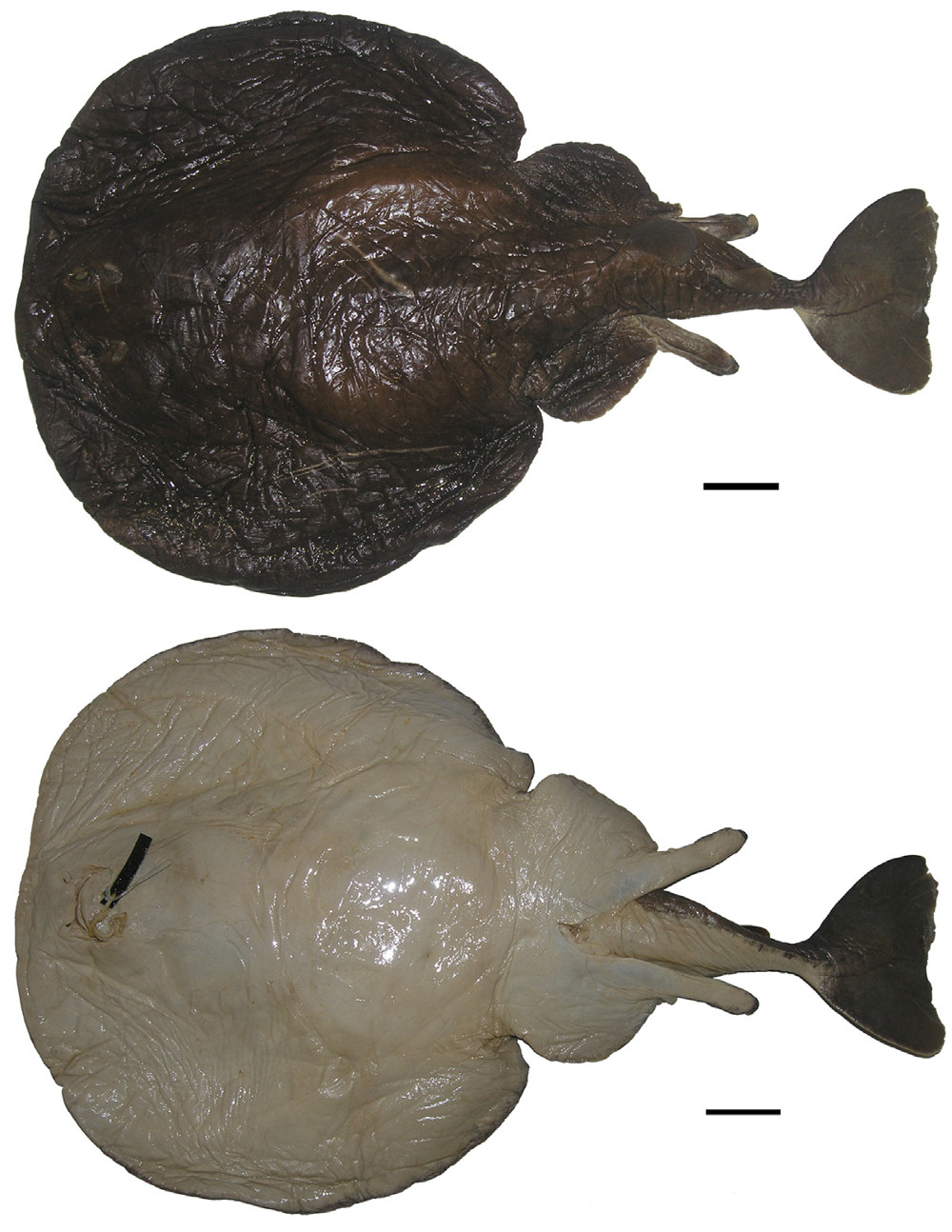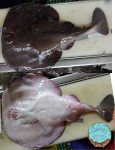Tetronarce cowleyi
Ebert, Haas & De Carvalho, 2015
Classification: Elasmobranchii Torpediniformes Torpedinidae
Reference of the original description
Tetronarce cowleyi, sp. nov., a new species of electric ray from southern Africa (Chondrichthyes: Torpediniformes: Torpedinidae). Zootaxa, 3936(2), 237–250
Tetronarce cowleyi, sp. nov., a new species of electric ray from southern Africa (Chondrichthyes: Torpediniformes: Torpedinidae). Zootaxa, 3936(2), 237–250
Description :
Citation: Tetronarce cowleyi Ebert, Haas & De Carvalho, 2015: In: Database of modern sharks, rays and chimaeras, www.shark-references.com, World Wide Web electronic publication, Version 01/2026
Please send your images of "Tetronarce cowleyi" to info@shark-references.com

Tetronarce cowleyi Ebert, Haas & De Carvalho, 2015, holotype SAIAB 25190, 626 mm TL, mature male, Scale bar represents 5 cm, image by DAVID A. Ebert, Pacific Shark Research Center, Moss Landing Marine Laboratories

Tetronarce cowleyi Ebert, Haas & De Carvalho, 2015, holotype SAIAB 25190, 626 mm TL, mature male, Scale bar represents 5 cm, image by DAVID A. Ebert, Pacific Shark Research Center, Moss Landing Marine Laboratories
Common names
Cowley’s torpedo ray
Cowley’s torpedo ray
Short Description
Orignal diagnosis of EBERT, HAAS & DE CARVALHO, 2015 [22368]: A medium-sized Tetronarce species, with a uniform shiny black to dark gray live dorsal color, distinguished from its most similar congeners T. nobiliana and T. puelcha by the following combination of characters: shorter spiracular length (1.5–1.6% TL in T. cowleyi as compared to 2.6–2.8% in T. nobiliana and 2.4–3.1% in T. puelcha), a proportionally greater head length as measured between snout margin and fifth gill openings (30.5–31.2% TL in T. cowleyi vs. 24.7–25.8% in T. nobiliana and 26.8% in adult male T. puelcha), and a proportionally greater preoral snout length (8.9–9.3% TL compared to 7.4–7.6% in T. nobiliana and 6.5–8.4% in T. puelcha). Teteronarce cowleyi, n. sp., is further distinguished from T. nobiliana by its more circular anterior disc shape (vs. relatively straight), fewer tooth rows (32/28 in 626 mm TL adult male holotype vs. 38/38 in a 655 mm TL adult male T. nobiliana from the North Sea, and up to 53/52 in 555–740 mm TL adult T. nobiliana males from the Mediterranean), greater mouth width (1.5–1.7 times as great as interorbital width vs. 0.5–0.6 times interorbital width in T. nobiliana), smaller distance between second dorsal and caudal fins (3.5–4.9% vs. 6.6–6.8% in T. nobiliana), and greater clasper length (in mature T. cowleyi claspers extend nearly to lower caudal fin origin, while in T. nobiliana clasper extends only two-thirds the distance between second dorsal and caudal fins).
Orignal diagnosis of EBERT, HAAS & DE CARVALHO, 2015 [22368]: A medium-sized Tetronarce species, with a uniform shiny black to dark gray live dorsal color, distinguished from its most similar congeners T. nobiliana and T. puelcha by the following combination of characters: shorter spiracular length (1.5–1.6% TL in T. cowleyi as compared to 2.6–2.8% in T. nobiliana and 2.4–3.1% in T. puelcha), a proportionally greater head length as measured between snout margin and fifth gill openings (30.5–31.2% TL in T. cowleyi vs. 24.7–25.8% in T. nobiliana and 26.8% in adult male T. puelcha), and a proportionally greater preoral snout length (8.9–9.3% TL compared to 7.4–7.6% in T. nobiliana and 6.5–8.4% in T. puelcha). Teteronarce cowleyi, n. sp., is further distinguished from T. nobiliana by its more circular anterior disc shape (vs. relatively straight), fewer tooth rows (32/28 in 626 mm TL adult male holotype vs. 38/38 in a 655 mm TL adult male T. nobiliana from the North Sea, and up to 53/52 in 555–740 mm TL adult T. nobiliana males from the Mediterranean), greater mouth width (1.5–1.7 times as great as interorbital width vs. 0.5–0.6 times interorbital width in T. nobiliana), smaller distance between second dorsal and caudal fins (3.5–4.9% vs. 6.6–6.8% in T. nobiliana), and greater clasper length (in mature T. cowleyi claspers extend nearly to lower caudal fin origin, while in T. nobiliana clasper extends only two-thirds the distance between second dorsal and caudal fins).
Distribution
around southern Africa, from Walvis Bay, Namibia to Algoa Bay, Eastern Cape, South Africa [22368]; Source: www.gbif.org
around southern Africa, from Walvis Bay, Namibia to Algoa Bay, Eastern Cape, South Africa [22368]; Source: www.gbif.org
Biology
benthopelagic species, diet consists mainly of large bottom and pelagic bony fishes and small sharks [22368];
benthopelagic species, diet consists mainly of large bottom and pelagic bony fishes and small sharks [22368];
Size / Weight / Age
TL maximum females:1133 mm; TL maximum males: 680 mm. [22368]; Smallest free-swimming neonate recorded measured 186 mm TL [22368];
TL maximum females:1133 mm; TL maximum males: 680 mm. [22368]; Smallest free-swimming neonate recorded measured 186 mm TL [22368];
Habitat
marine; depth range: found along the outer continental shelf and upper slope near the bottom - 457 m [22368];
marine; depth range: found along the outer continental shelf and upper slope near the bottom - 457 m [22368];
Dentition
Orignal diagnosis of EBERT, HAAS & DE CARVALHO, 2015 [22368]: Teeth set in quincunx, flattened labial-lingually, morphologically similar in both upper and lower jaws, with well-developed single cusps;
Orignal diagnosis of EBERT, HAAS & DE CARVALHO, 2015 [22368]: Teeth set in quincunx, flattened labial-lingually, morphologically similar in both upper and lower jaws, with well-developed single cusps;
Remarks
shark-references Species-ID=14300;
shark-references Species-ID=14300;




















